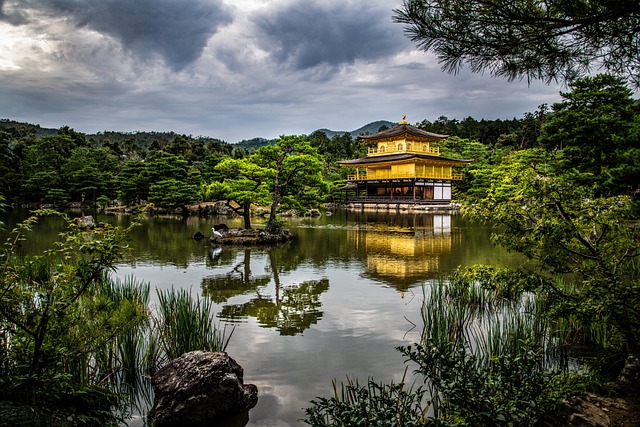Situated in the western part of Honshu, the largest island in Japan, Kyoto is a city that reverberates with history, culture, and elegance. Once the imperial capital of Japan for over a thousand years, Kyoto is often regarded as the cultural heart of the nation. It is a place where ancient traditions intermingle seamlessly with modern life, offering visitors a unique glimpse into the past while still being vibrantly alive in the present. If you’re considering a trip to this stunning city, this guide will provide you with everything you need to know to navigate its historical landmarks, natural beauty, and culinary delights.
A Brief History of Kyoto
Kyoto’s history dates back to the 8th century when it was known as Heian-kyo, or “Capital of Peace and Tranquility.” It was chosen as the capital of Japan in 794, and it remained the heart of Japanese politics and culture until the capital was moved to Tokyo in 1868. Over the centuries, Kyoto flourished as a center for the arts, including poetry, tea ceremonies, and traditional crafts.

Despite the ravages of time, including several fires and the devastation of World War II, Kyoto still boasts a remarkable collection of historical structures, including temples, shrines, and traditional wooden houses, reflecting the city’s rich cultural legacy.
Unmissable Attractions
1. Kinkaku-ji (Golden Pavilion)
One of Kyoto’s most iconic landmarks, Kinkaku-ji, officially known as Rokuon-ji, is a Zen Buddhist temple covered in gold leaf. Nestled amidst lush gardens and a reflective pond, this stunning temple is a masterpiece of Japanese architecture and aesthetic principles. The beauty of the Golden Pavilion changes with the seasons, providing a different but equally breathtaking vista whether it’s enveloped in cherry blossoms in spring or vibrant fall colors.
2. Fushimi Inari Taisha
Fushimi Inari Taisha is renowned for its thousands of vermilion torii gates that wind their way up the sacred Mount Inari. The path leading through the gates takes about two hours to walk, offering visitors a fully immersive experience in nature and a sense of spiritual connection. The shrine is dedicated to Inari, the Shinto god of rice, and it is a hotspot for tourists and locals alike, especially during early morning and sunset hours for the most magical transformations of light.
3. Arashiyama Bamboo Grove
The Arashiyama Bamboo Grove is a serene and enchanting destination, often featured on many travel bucket lists. Walking through the towering stalks of bamboo creates a natural symphony as the wind whistles through the leaves. Surrounding the grove are other attractions, including the Iwatayama Monkey Park, where you can see Japanese macaques in their natural habitat, and the picturesque Togetsukyo Bridge, which offers stunning views of the surrounding hills.
4. Kiyomizu-dera
Kiyomizu-dera, or “Pure Water Temple,” is a UNESCO World Heritage Site famous for its wooden stage that juts out over the hillside, providing breathtaking views of the cherry and maple trees below, which dramatically change with the seasons. The temple’s name comes from the Otowa Waterfall, which flows beneath the main hall. Visitors can drink from one of its streams for health, longevity, and success in love. The surrounding district of Higashiyama is equally charming, filled with traditional tea houses, shops, and narrow streets leading up to the temple.
5. Gion District
No visit to Kyoto is complete without experiencing Gion, the city’s famous geisha district. Known for its traditional wooden machiya houses, Gion is where you can spot geiko (the Kyoto term for geisha) and maiko (apprentice geisha) in elegant kimonos, particularly in the evening as they make their way to tea houses. The area is rich in cultural heritage, and visitors can enjoy traditional performances at the Gion Corner or partake in a meal at a kaiseki restaurant, where a multi-course culinary experience awaits.
Experiencing Kyoto’s Seasons
Kyoto’s beauty is accentuated by its changing seasons, making it an attractive destination year-round.
Spring (March to May)
Spring is perhaps the most popular time to visit Kyoto, primarily due to the cherry blossom (sakura) season. Hanami, or flower viewing, is a time-honored tradition where locals and tourists alike gather in parks, temples, and along the Philosopher’s Path to appreciate the blooming sakura. The soft pink blossoms create a stunning backdrop and evoke a sense of serenity.
Summer (June to August)
Summer in Kyoto can be hot and humid, but it also brings vibrant festivals, such as the Gion Matsuri, one of Japan’s most famous festivals held throughout July, featuring parade floats and traditional music. The surrounding hills provide opportunities for hiking and nature walks, allowing visitors to escape the city’s heat.
Autumn (September to November)
Autumn offers a breathtaking display of koyo (autumn leaves). Visiting gardens and temples during this season enables travelers to witness the vibrant reds, oranges, and yellows coating the foliage. The views from Kiyomizu-dera and other scenic spots are particularly rewarding.
Winter (December to February)
If you prefer fewer crowds, consider visiting in winter. The city’s temples and shrines take on a peaceful atmosphere, and the potential for snowfall adds a magical touch. Many temples have illuminations during this season, providing a unique perspective of their beauty.
Culinary Delights of Kyoto
Kyoto is not only a feast for the eyes but also the palate. The city boasts an array of culinary offerings, from traditional kaiseki (a multi-course haute cuisine) to street food delicacies.
1. Kaiseki
A testament to Kyoto’s culinary artistry, kaiseki is a traditional multi-course meal that emphasizes seasonal ingredients, precision in each dish’s presentation, and the art of balance. Several restaurants in the city offer this exquisite dining experience, often set in tranquil settings that enhance the meal’s enjoyment.
2. Yudofu
Yudofu, or boiled tofu, is a local specialty that highlights the quality of Kyoto’s tofu production. Enjoying this dish, especially in a peaceful temple setting, allows you to taste the essence of Kyoto’s culinary simplicity.
3. Matcha

Kyoto is also renowned for its high-quality matcha (powdered green tea). Visit tea houses around the city for matcha desserts, such as ice cream or traditional sweets. Participating in a tea ceremony can further enhance your understanding of this integral part of Japanese culture.
4. Nishiki Market
A visit to the Nishiki Market is a must for food enthusiasts. This vibrant market features a plethora of local vendors selling fresh produce, traditional sweets, pickles, and artisanal crafts. It is an excellent opportunity to taste various local specialties and shop for souvenirs.
Practical Tips for Visiting Kyoto
- Transportation: Kyoto has an extensive public transportation system, including buses and trains. A prepaid IC card (like Suica or ICOCA) will make travel more convenient. Consider staying near major attractions or train stations to maximize your time.
- Etiquette: Familiarize yourself with basic Japanese etiquette, such as bowing when greeting and removing your shoes when entering someone’s home or certain traditional establishments. Always be respectful at shrines and temples.
- Cultural Sensitivity: Engage with local customs and practices respectfully. For example, follow the rules for photography in sacred spaces and be mindful of noise levels in public transport.
- Timing: Try to visit popular attractions early in the morning or later in the afternoon to avoid crowds. Many temples and shrines have opening hours and can be particularly stunning during sunrise or sunset.
Kyoto is a city that invites exploration, offering profound insights into Japan’s rich cultural and historical tapestry. From serene temples and lush gardens to delicious cuisine and vibrant districts, each experience fosters a deeper appreciation for the art of living in harmony with nature and tradition. As you traverse its streets and monuments, you may find that the spirit of Kyoto stays with you long after your visit—a timeless journey in one of Japan’s most treasured locales. Whether it’s your first visit or a return to rediscover its charms, Kyoto never fails to captivate. Happy travels!



Kyoto truly sounds like a magical place where history and modernity coexist in harmony. I’ve always been fascinated by cities that manage to preserve their cultural heritage while embracing the present. The fact that Kyoto was the imperial capital for over a thousand years is astounding—it must have shaped so much of Japan’s identity. Kinkaku-ji and Fushimi Inari Taisha seem like must-visit spots, especially with their seasonal transformations. I wonder, though, how does Kyoto manage to maintain its traditional charm amidst the pressures of modernization? Also, are there any lesser-known gems in the city that you’d recommend for someone looking to experience its authentic side? I’d love to hear your thoughts!